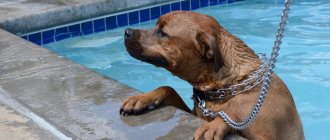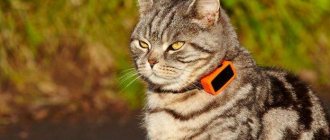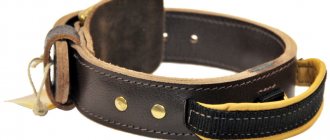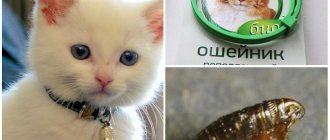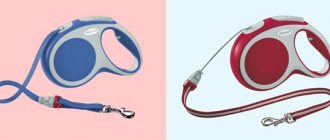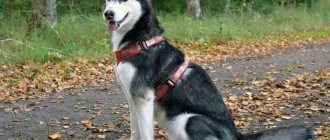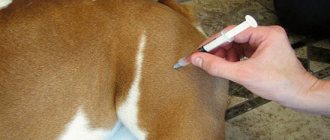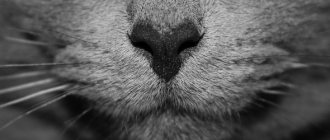A dog harness is a restraint device that is placed on an animal and connected to a leash. They can be for walking, riding, for training, guard and search work, medical, with insulation against the cold or weighting for muscle training.
The devices differ in size depending on the size of the dog: the minimum is XXS, the largest is XL. They are determined by the girth of the animal's chest. This indicator, as well as the length of the back and neck circumference, are needed to make your own harness. But it is better to buy a finished product from Ferplast, Ruffwear, Haqihana. They are made of hypoallergenic synthetic materials, with durable fasteners, and you can choose a device depending on the purpose of use.
Dog harness: what is it, what is it for?
A harness for different breeds of dogs is a device that can replace a collar when walking or during training, only more convenient and safe. It looks like a harness that covers the chest, the part of the abdomen close to it, the sides, and fastens on the back in the area of the front legs. The device can consist only of intersecting belts with fasteners or a bib, blankets, slings connecting them, and clamps. A dog harness is needed to:
- the pet remained under the control of the owner, and did not damage its cervical spine or throat during sudden movements;
- walking animals that are recovering from injuries to their hind legs or old ones that have problems with their limbs;
- teach a dog that has not yet been trained to obey while walking and wear a leash;
- use an animal in a harness or for protection, search, or as a guide;
- ensure muscle strengthening while walking (models with weights).
There are many types of harnesses, but each one should be comfortable for the dog, not squeeze the body, and not dangle. Fasteners that are strong and do not interfere with the animal, as well as the materials used, are also important. The latter should be durable, moderately elastic, easy to wash, and comfortable to wear.
It is also important to choose the product by size. There are several of them, and they depend on the size of the dog and the circumference of its chest:
- XL for the largest breeds with a volume of 90-130 cm;
- L for those that are smaller, with the same indicator 70-100 cm;
- M for animals slightly larger than average, with a girth of 60-80 cm;
- S for dogs of medium size, with an indicator of 50-70 cm;
- XS for small ones, with a girth of 40-55 cm;
- XXS for indoor decorative with a volume of 33-45 cm.
We recommend reading about how to train your dog to use a leash. From the article you will learn about the best age to teach a dog to use a leash, the owner’s rules of behavior during training, and the organization of walks without a leash.
And here is more information about how to choose/sew a protective collar for dogs.
Which is better - a harness or a collar?
A dog collar that fits over the paws has both pros and cons compared to a regular one. To choose between it and a harness, you need to take into account the breed, size and character of the animal, and the appropriateness of wearing the accessory:
| Advantages | Flaws | |
| Collar | Comfort when choosing the right model according to size | The risk for restless dogs to injure the spine |
| Hygiene and practicality | The appearance of abrasions on the neck, deterioration in the quality of wool when choosing the wrong size | |
| Large selection, availability of models that can also decorate a dog | Compression of the throat when the animal jerks | |
| Affordable price | ||
| Harness | The ability to choose an accessory according to the size of the dog’s neck, even when its girth is larger than its head | Can't be worn all the time |
| More uniform load on the animal's spine | It is more difficult to put on a mobile pet, especially when he resists | |
| Less likely that the animal will be injured when jerking | Selecting a model will require more time and measurements than a collar | |
| There is less chance that it will escape from the owner's control | Higher price | |
| Possibility of training muscles and the musculoskeletal system when using a weighted model | For shaggy dogs, there is a risk of thinning hair in areas of contact with the straps, which spoils the exterior |
A harness is a device that dogs do not wear at home, but it can help them get used to the collar, behave more calmly during walks, and obey their owner.
Main types
The following types of dog walking harnesses are known and used:
- with weights;
- soft walking;
- sled or for harness;
- intended for guard animals, security guards, search engines;
- insulated or vest;
- to relieve stress on the hind legs.
With loads
A holding device with weights is useful for an animal:
- overweight;
- preparing for competitions;
- recently suffered a paw injury.
Weight harness
In the first two cases, walking and exercising in harness will allow the dog to feel a greater load in movement, which helps to reduce body weight and strengthen muscles. In the latter, a weighted harness, on the contrary, reduces the participation of the sore paw in walking, as it will not allow the animal to be too active.
Soft
Soft ammunition is made of genuine leather, fabric, sometimes with additional inserts and is more suitable for small dogs or animals with an easy-going disposition. The device will provide comfort and allow you to control your pet during walks. Harnesses made of soft material come in a variety of shapes:
- "wings";
- "liberty"
- vest.
Harnesses made of soft material
The straps are not too wide to hold the dog without causing him discomfort.
Harness, sledding, traction
A sled device, or sled harness, exists for dogs that participate in competitions while harnessed to a sled, or are used on the farm, for example, among northern peoples. These are malamutes and huskies, that is, quite large animals. But comfort and health are also important to them, so the traction harness must have:
- durable belts, so they are made of canvas or nylon;
- ergonomic design so that when moving in a harness, the load is distributed evenly and no abrasions occur;
- be light in weight so as not to additionally burden the animal.
Riding harness
For ZKS, tracking work
The device for the PCS (protective guard service) is quite large, as it is intended for large dogs. Usually this is a triangle for the chest and a blanket on the back, connected by straps, which are secured with rings for reliability. The first two parts are soft, and the lines are wide and durable. This harness is also suitable for tracking and training. It will not allow the animal to break loose, but will not cause any inconvenience when executing commands.
Harness for ZKS
Collar-harness, or walking
The walking harness is made of soft material (leather, nylon fabric) and has a minimum of belts. It is comfortable for the animal to walk or run, without jumping or sudden jerks to the side, so the device is not suitable, for example, for training. The peculiarity of a collar-harness is how it fits on the body: it should be tight, but not restrictive.
Collar-harness
For the dog's hind legs
A support device for a dog’s hind legs is necessary if there are problems with them: joint weakness due to old age, rehabilitation after injury or surgery. It allows you to limit the load on them while driving. The device may be:
- a pad wrapped around the waist, and there should be free openings for the limbs and tail;
- a mix of a traditional harness and the same device for the back of the animal’s body, which looks like a harness;
- a corset that immediately covers the pet’s back, sides and stomach, connected to a regular harness.
Hind leg harness
Vest
A device in the form of a vest not only allows you to securely hold the animal, but also warms it, as it covers a significant part of the body. It is needed mainly by small dogs, classified as indoor or decorative, with short hair. The device is also suitable for weakened animals that need to reduce the load on their hind legs when moving. The harness-vest can be made of leather with faux fur or thick fabric.
General recommendations from dog handlers on the selection and use of collars
- Do not purchase products with spikes or rivets on the outside of the collar. They can injure surrounding people and animals. Your pet may injure its paws while trying to remove the product from its head. While playing, the dog may accidentally bite off the rivet and swallow it.
- Evaluate the reliability of the collar accessories (clasps, locks, rings).
- Decorative inserts on the collar should not cause discomfort to your dog.
- The collar should be periodically wiped with a damp cloth and cleaned of dirt.
- If the metal elements of the product are rusty, they need to be replaced. The collar can be coated with a special compound that prevents the formation of rust.
- Never put someone else's dog's collar on your pet. You can infect your animal with an infection or parasites.
- The width of the collar should be selected depending on the size of your pet.
- The collar buckle should be at some distance from the ring. This design will help to evenly distribute the load on the equipment.
- The diameter of the neck may change due to various circumstances (molting, time of year, etc.). A leather collar also changes its size (stretches when wet and shrinks when dry). Taking these circumstances into account, you should choose a product with the maximum number of holes.
- The collar should not be too tight.
- Multilayer equipment has great reliability and durability.
- You should not buy collars with plastic fittings. Plastic fasteners are not very reliable and break easily in the cold.
- On the website of collar manufacturers you can find special tables that will help you choose ammunition.
- Cheap metal collars may have poorly processed links, the surface of which is covered with jagged edges. The collar must be carefully inspected before purchase for mechanical damage.
Dimensions: table
The harness should fit well on the animal, not put pressure or dangle on the body, and for this you need to select the size according to the table:
| Size | Sling width, mm | Chest circumference, cm | Examples of breeds |
| XL | 25 | 90-130 | Central Asian and Caucasian Shepherd Dogs, Dogue de Bordeaux, St. Bernard, Newfoundland |
| L | 25 | 70-100 | German Shepherd, Giant Schnauzer, Doberman, Rottweiler |
| M | 25 | 60-80 | Labrador, golden retriever, setter, boxer |
| S | 20 | 50-70 | Spaniel, beagle, miniature schnauzer, fox terrier |
| XS | 15 | 40-55 | Pug, small poodle, Shihtzu, Boston terrier |
| XSS | 15 | 33-45 | Yorkshire Terrier, Toy Terrier, Chihuahua, Miniature Pinscher |
Material quality
Devices are made from:
- synthetic fabric (canvas, nylon, nylon, velor);
- braided braid;
- genuine leather or its substitute.
They are often combined in one product. The material from which the harness is made must be durable, wear-resistant, elastic, but not too stretchy. And also soft on the side that touches the animal’s body. It is imperative that the product is easy to wash and dry quickly.
Number of fasteners and straps
To accommodate a small dog, one fastener and straps connecting the chest part to the blanket are enough. It could even be Velcro or a plastic fastener.
If the dog is large and the harness is for walking, several fasteners are needed for training or performing protective and guard functions, at least three. And it’s better to have full-fledged belt fasteners, rings, carabiners or buttons. This will ensure that the device is easy to put on, securely attached to the body, and comfortable to wear for the animal. Fasteners should be positioned so as not to rub the skin or interfere with movement.
Watch this video about the types of harnesses and leashes for dogs:
Taking measurements
The main and important point when choosing clothes and equipment for your beloved pets is taking the correct measurements, which in the future will allow you not to make a mistake with the size. The parameters need to be taken as accurately as possible, close to the dog, but without over-tightening.
Important: for the most accurate indicators, the dog must stand when taking measurements! Its volumes need to be measured in the widest places.
For chest volume, measure the widest part of the chest. For the final result, it is recommended to add a couple of centimeters to the resulting size - for a looser fit of clothing.
To determine the volume of the neck, measure the widest part.
To measure the length of the back, the dog must be standing straight. Using a measuring tape, take measurements from the spine, from the highest point of the back to the beginning of the tail.
Attention: if the animal is large, then one size must be added to the measurement results.
Dog clothing size chart
| Number | Size | Back length | Chest volume | Weight, kg |
| 1 | Xs | 18-21 | 26-30 | 1-2 |
| 2 | S | 22-25 | 31-34 | 2-3 |
| 3 | M | 26-30 | 35-40 | 3-4 |
| 4 | L | 31-35 | 41-45 | 4-6 |
| 5 | Xl | 36-41 | 46-50 | 6-8 |
| 6 | Xxl | 42-47 | 50-55 | 8-10 |
| 7 | Xxxxl | 48-53 | 56-60 | 10-15 |
| 8 | Xxxxl | 54-60 | 61-70 | 15-25 |
| 9 | Xxxxxl | 61-67 | 71-80 | 25-35 |
| 10 | Xxxxxl | 68-73 | 81-90 | 35-45 |
Table of clothing sizes by breed
| Size | Breed |
| Xs | Chihuahua, toy terrier, mini Yorkie, small breed puppies. |
| C | Yorkshire Terrier, Toy Terrier, Maltese, Japanese Chin, Pomeranian Spitz. |
| M | Chinese Crested, Pug, Toy Poodle, Large Yorkie, Shih Tzu, Miniature Pinscher. |
| L | Miniature poodle, shih tzu, fox. |
| Xl | Cocker spaniel, poodle. |
| 2 Xl | Boston Terrier, Shih Tzu, Pug, Cocker Spaniel. |
| 3 Xl | Cocker spaniel, bull terrier. |
| 4 Xl | Golden Retriever. |
| 5 Xl | Golden Retriever. |
| 6 Xl | Saint Bernard, Rottweiler, Bernese Mountain Dog. |
How to choose a dog harness
You will be able to choose a comfortable harness for your dog if:
- know the size of the animal, that is, the length of the back, the girth of the chest and the base of the neck;
- determine which series of breeds it belongs to, because for large, medium and small dogs, devices differ in material, design and size;
- know what a harness is for, since products for walking, participating in an exhibition, training, guarding, and sledding are also not the same.
Puppies need very soft adaptations. The product has a large number of straps and a handle to support and carry the animal by the owner - a sick and weakened animal.
Important “little things”
Before purchasing a harness, you must take into account some features that will determine the level of comfort for the animal during a walk or training:
- it doesn’t matter what material is used (nylon or leather) - the main thing is that the product is durable, wear-resistant and easy to use;
- Belts and fasteners should not fit too tightly to the animal’s skin, as this will cause discomfort.
You can buy an original dog harness in St. Petersburg at competitive prices on our online store. If you have any difficulties choosing a specific product model, our experienced consultants will help you make the right decision.
How to choose by size
You can choose the size of a harness for any breed of dog by measuring its main parameters:
- The length of the animal's back. You need to start from the base of the withers and to the point where the tail grows.
- Neck circumference. To determine the indicator, a centimeter tape is wrapped where the collar is usually located, that is, at the base.
- Chest circumference. Its size is determined by the widest point in this area.
To measure your dog to select a harness, you should wait until he is able to sit quietly. The wool must be pressed during manipulation. And yet, it is necessary to add 0.5-2 cm to the girth of the neck and chest, taking into account its thickness and the fact that the product should not squeeze.
It’s more difficult, but also realistic, to choose a harness for your dog without trying it on. If it is not possible to find out its parameters, you need to focus on the breed and sizes from the table. After all, usually the belts of the product can be tightened or loosened to a certain extent, adjusting it to the dimensions of the animal.
For small dogs
For small dogs, a fabric device or one made of leather straps is suitable, preferably with a handle that allows the owner to lift the pet.
Animals of sizes XS or XXS do not have much strength and do not need to be additionally restrained using a powerful harness. Small dogs with short hair will need a fur vest during the cold season, such as a harness for a pug. These animals also have a wider neck than the head circumference, so the device will not allow the pet to get rid of the leash.
A harness in the form of a vest is also suitable for Yorkshire terriers, who have long hair, but it does not always save them from colds. A Chihuahua needs a light fabric device in the summer so that the restless and often timid animal does not strain its neck muscles while walking. And in winter, you need a walking harness with fur that will prevent the tiny creature from freezing.
For large breed dogs
For large breed dogs, you should buy a device in size XL or L. If the animal is trained to behave calmly on the street, in the midst of people, you can buy a walking harness. It's minimal fabric, more comfortable, but usually durable enough to take your dog out.
To perform security and investigative activities or work in a harness, a more reliable device is needed, that is, a two- or three-layer device specially designed for this purpose. The first usually consists of a triangular bib, blankets, and belts secured with rings. And the riding device is a sling that crosses under the chest and on the back, allowing you to evenly distribute the load. And yet, a working harness for a shepherd, husky, or malamute should not deprive the animal of comfort.
Sling harness for husky
For medium dogs
Adaptations for medium-sized dogs should be selected based not only on the size, but also on the breed of the animal, since among them there are absolutely calm, friendly and quite active, aggressive ones. For example, a Pit Bull Terrier owner should look for a size M "harness" with wide fittings. A walking harness for a husky can only consist of a minimum of belts. For the harness, she will need a special device with a lot of slings.
For a puppy
A harness for a puppy should be soft and especially comfortable, without weights. And you can’t buy it “for growth,” since even a product that is the right size, put on too early, can disrupt the baby’s development. The device can only be used from the age of six months if the breed is small. Owners of large ones will have to wait until the pet is 9-10 months old.
For a disabled dog
A product for a disabled dog must have two features:
- Cover a much larger portion of the body than is appropriate for a healthy animal. Sometimes the head, paws and tail remain visible. But a harness can consist of belts covering not only the dog’s chest, but also the stomach and back of the body.
- Among its components is a handle or lifting panel located on the front edge of the blanket. The owner takes it when he needs to help the dog move or carry it in his arms.
For the exhibition
When going to an exhibition with your dog, you should not have a harness, but a show ring, that is, a device consisting of:
- a ring with a limiter, worn around the animal’s neck;
- leash with a loop at the end for the owner's hand.
The product must be selected to match the color of the pet’s coat so that it does not interfere with the judges’ assessment of its exterior.
General information about harnesses
It is necessary to choose ammunition individually for each dog.
The harness consists of belts covering the chest and back of the pet. This type of ammunition helps the animal develop endurance and strength, and strengthen muscles.
All this allows you to replace the collar with a harness. A leash or tape measure is attached to it near the withers, back or croup. Unlike a collar, a harness does not put pressure on your pet's throat. This device does not restrict movement and allows you to breathe freely and easily.
Depending on the functions, there are several types of harnesses:
- Regular (walking) - worn while walking. It does not put pressure on the neck, so it is very useful for dogs with thick necks who are prone to pathologies such as eye loss.
- Medical (veterinary) - is a vest that covers two-thirds of the body. There is a fastening located near the hind legs. This design helps to walk paralyzed and injured dogs. When walking, the pet rests on its front paws.
- Harness-vest - filled with insulating material, so it warms the dog in the cold season. Most often it is used for small and medium breeds.
- A sled is an item made of dense synthetic material that is attached to the dog’s croup. Used in dog racing. This device was first invented by the Indians of North America. Helps the dog carry light weight over long distances.
- Guard - very durable ammunition for service dogs.
- Tracking - for a service dog following a scent. A little lighter than the guard.
- Special - for guide dogs. Consists of straps to which a hard plastic handle is attached. A blind person is holding on to this handle.
Medical model
Ammunition is made from various materials: leather, faux leather, thick fabric, nylon, tarpaulin.
Puppies older than 6–10 months can be fitted with a harness.
Attention! Before reaching this age, such a structure cannot be worn, otherwise the puppy will develop pathologies of skeletal development. You need very light ammunition, ideal in size.
The best dog harnesses from manufacturers
The best harnesses for different dog breeds are made by:
| Name | Description | Photo |
| Ferplast | The company's products are mainly made of nylon; there are lightweight products with insulation for training and walking. | |
| Ruffwear | These are products made to high design standards, comfortable and ergonomic. Among them there are walking ones in the form of intertwined belts, multifunctional ones with reflective elements, for playing sports. | |
| Haqihana | These harnesses were developed by dog handlers and are made of nylon. They have 5 elements for changing the length of the belts. Walking devices are especially loved by dog owners, as they are strong and smooth slings connected by Wienerlock fastenings that do not injure the animal. |
How to assemble a harness correctly
Assembling the walking harness correctly is simple:
- separately connect the rings that will encircle the chest and the front part of the body;
- attach to each a jumper intended for the gap between the front paws;
- fix the rings together where the leash should cling, this point will be on the dog’s back.
Option #1
Option No. 2
Other types of devices are assembled using the same principle. The leash should always be attached from above, and not from under the animal's chest. And you also need to understand where to put the paws and head, then the assembly diagram will turn out to be quite simple. But usually products always have instructions.
General requirements for harnesses
For walking with a dog, a harness is the most convenient and safe accessory.
The history of the appearance of this accessory is connected with the need to transport cargo with the help of dogs. The classic device consisted of two belts that were connected along the spine along the back and in front between the paws of the animal. This design ensured optimal distribution of the load between the dog's chest and front legs. Due to the fact that there was no pressure on the neck area, the animal was comfortable.
Important ! The device should be free, but not very loose. If the fastenings are weak, it will be uncomfortable for the dog to walk, and he may also wriggle out and run away.
Depending on their purpose, harnesses can be used for riding, walking or medical. Breeders recommend purchasing several types at once in order to use them for different purposes. Before purchasing, you need to try the accessory on your animal.
DIY dog harness: step-by-step instructions
A dog harness can be created with your own hands; step-by-step instructions look like this:
- take measurements from the dog (neck and chest circumference, distance between the base of the neck and the chest);
- from a wide braid, cut off the parts of the device, that is, tapes for the chest and upper abdomen, a jumper between them, which will be located between the front legs of the animal;
- cut out the same components from fabric;
- connect blanks of material with braid so that each part becomes three-layer (fabric inside);
- attach clamps to the ends (buttons, if the dog is small, belt ones);
- To the edges of the parts that will be on the pet’s back, also sew elements connecting the structure and, of course, a metal ring to which the leash will cling.
We recommend reading about how to transport a dog. From the article you will learn about the general rules for transporting a pet, organizing a trip with a dog by car, bus, plane, rail and bicycle.
And here is more information about how to organize the transportation of dogs in a car.
A finished harness can cost from 1500 rubles. up to 5000 rub. But you shouldn’t waste money if you can’t sew it yourself. After all, a high-quality product will help the dog become more manageable, maintaining its health and good contact with the owner.
